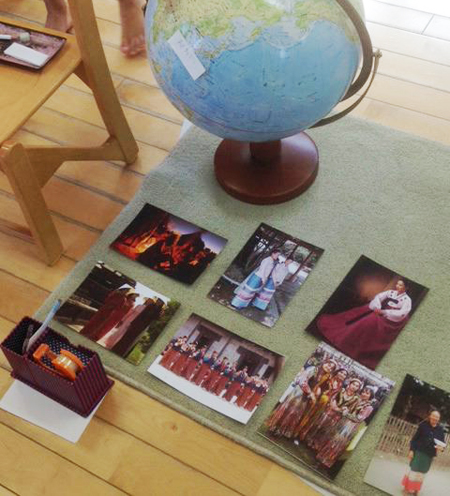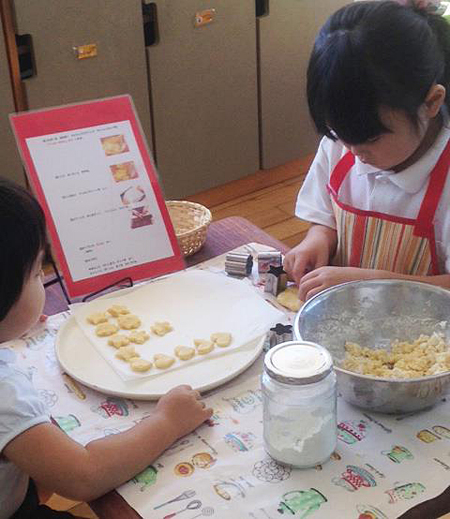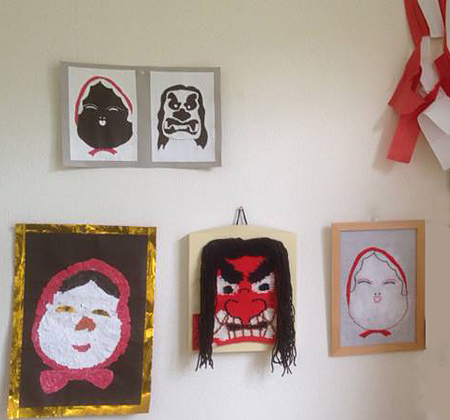For Teachers:
CLASSROOM HOLIDAY CELEBRATIONS
MONTESSORI STYLE
— Cathryn Kasper, AMI Montessori School Consultant



CELEBRATING HOLIDAYS,
THE OLD WAY AND THE NEW
For many of us, holiday celebrations are all we remember fondly in our early preschool or school years. It might be that the rest of our year was just not that memorable or enjoyable. Sometimes we forget that in a good Montessori class every day is fun, every day is memorable! The day is filled with wonderful activities, each child choosing what to work on, the 3-hour minimum work period devoid of any required adult-directed group activities. This gives children the chance to delve deeply into their activities, to concentrate, to work carefully, and to feel proud of accomplishments. The holiday spirit of giving and helping is an everyday experience in these classes, not something that is saved for special events.
AGE 1-6 CELEBRATION IDEAS
ADAPT THE CLASSROOM
NOT THE SCHEDULE
A sense of order, both in the physical environment and in the schedule is very, very important in the Infant Community (age 1-2.5) and the Primary Class (2-6). It provides an important sense of security to know that the schedule will remain the same during the holidays, and there will be very little change in the environment. However, subtly and carefully adapting the environment to reflect holidays and nature in the changing seasons, rather than changing the schedule, is what we do. Here are some ideas:
SONGS, POEMS, and FINGERPLAYS: These activities erupt spontaneously throughout the day in the Montessori class, one child singing, a child asking the teacher or older child to read one of the poetry cards. In the weeks ahead of a holiday the teacher changes the card collections to include the songs, poems, and fingerplays that teach the child about the coming holiday. By the time the holiday arrives the children will be fluent in them, even sharing them at home.
BOOKS: Books about the coming holiday should be added to the library corner at least a month before the holiday, so there is plenty of time for children, one at a time, to look through them and even to read to each other. Or for the teacher to read, also to just one child or to a small group.
ART: In traditional schools it is quite common for the teacher to draw and cut out, for example, a pumpkin. And then give each child a piece of orange paper and help him cut out 'his' exact replica. This is often called "creative" or "art." In my opinion it is neither. Instead, since one finds examples of great art, framed and hung at the child's eye level throughout the classroom, in preparation for the coming celebration, these art pieces can be changed to reflect the coming holiday.
This wall art, as well as the books, can serve as an inspiration for the children to make their own unique pieces of art, as in the Japanese class where I took the picture at the top of this page.
Special colored paper can be added to the art shelves, black and orange before Halloween, the color of fall leaves and pumpkins before Thanksgiving, blue and white paper before a Jewish Holiday. Black, red and green for Kwanzaa.
LOGICAL QUESTION GAME STORY: This is one of the most enjoyable experiences in the 3-6 class. The teacher asks questions to a small group of children around a central theme, such as "Father Bakes a Cake." These questions draw out all of the bits and pieces of this experience, what utensils and ingredients are needed to bake, why he is baking, the steps, and so forth. Then, the teacher pulls it all together logically and tells a story. This is the favorite kind of story at this age and the subject can be the coming holiday, as the older children in the class will be used to the process and have a lot to offer. The youngest will be delighted with the process and the resulting story. It need be only a few sentences long but it will be satisfying. Some examples are: getting and putting up a Christmas tree, going trick or treating at Halloween, putting on all the clothing necessary for playing in the snow, cleaning the house because company is coming . . . the possibilities are endless.
MATH: in classes where a simple story problem is written on the black board before the children arrive, always solved by one of the older children by the end of the day, the subjects are easily adapted to the coming holiday, "If John had 6 pumpkins and shared them out among three friends, how many pumpkins will each child receive?"
PRACTICAL LIFE: Most holidays have special food connected with the celebration and this can be incorporated in the the daily life of the classroom. In the picture above a child is reading the recipe for baking cookies and following the directions. Even for children who are not yet reading, there are plenty of ways to participate in holiday food, cleaning out pumpkins and washing the seeds to bake, cutting out cookies in the shape that represents the holiday. This depends on the country and the foods used for the celebration.
SEWING: I once observed in an Infant community for ages 1-2.5, where a parent had set up a little art project in the corner of the room. One at a time, a child was invited to come and use fabric dye and eyedroppers to create an artistic design on a small square of white fabric. The parent then made a quilt out of the squares for a school fundraiser. In another class in another school the 2-6 year-olds learned quilt-making with similar size squares. I thought how delightful it would be for the decorating of the fabric, and the making of a quilt, to be happening in the same school, mostly by the children.
TABLECLOTHS, PLACEMATS, ETC: Again, in changing the environment, rather then the children's schedule's, the equipment in some cases, baskets that hold the geometric solids and the silk scarf that covers them, placemats and napkins, trays and bowls used to set the table, can be changed to reflect the colors and the images connected with the coming holiday.
UNINTERRUPTED WORK IN THE 3-HOUR WORK PERIOD: I hope that all of these ideas can help you keep the daily schedule, and the protection of the vital 3-hour work period, unchanged as you come up with other ways to adapt the environment. There will be plenty of emphasis on holidays OUTSIDE the classroom as each approaches. The Montessori classroom, and the unchanged daily schedule, is an oasis of security and peace during these times of the year.
Even though the day goes on as usual, children at this age "absorb" the beauty, charm, and historical and cultural significance, of holiday celebrations going on around them. They will learn from the books, from the poems and stories, from the songs, from the holiday foods, the art, the colors that are highlighted in the classroom. They will feel included when they hear these things being discussed in their lives away from school.
But most of all, they will not be missing out on the most important element provided them in their Montessori experience: the calm, busy, happy work, on purposeful activities involving their hands and heads acting together, and the kindness of their community.
ALERTING THE PARENTS: It is important to let parents know how differently we handle traditional holiday celebrations in the Montessori world, rather than emphasizing traditional large group activities and gift-making. They will have something special to talk to their children about; they can do similar things in the home; and they will have a deeper understanding of their child's Montessori experience.
AGE 6-12+ CELEBRATION IDEAS
Follow the child!
In the 3-6 class it is the 3-hour work period of each morning, and in some cases also in the afternoon, that is protected from adult direction and from interruption of concentration. However at age 6-12, students are responsible for much longer periods of time, days, weeks, even months and these also need to be protected from adult direction. In the beginning of the year the students are made aware of the expected standards for each grade level for their particular country or stage. They are invited to the Great Lessons in the beginning of the year, and then, with gentle guidance from the teacher, they learn to plan their day, to manage time, to get the "state required" work done, and to keep their own projects balanced throughout the different areas of the Montessori curriculum. We must be very careful, just as we were with the 3-hour work period for the younger children, to respect student plans and choice at this level.
Students at this level are interested in history throughout the ages, about the mental and spiritual needs of humans, how they celebrate and have celebrated throughout history. They weave their studies into plays and songs and stories, timelines, physics experiments, all kinds of creativity.
It is so tempting, when something is enjoyed one year (a class trip, a play, a field trip to a particular museum, cooking Thanksgiving dinner, a fundraising art project, and on and on) NOT to make it part of every year from then on! But it is important to through aside all of the "success" stories of holiday celebrations and other activities of the past, to start each year new, and to let the creations come from each new group of students. Even though many students return year after year, the dynamics change each year, and so will the creativity and the celebration.
These holiday suggestions are provided by the Michael Olaf Montessori Company MichaelOlaf,
written by Susan Mayclin Stephenson Susan